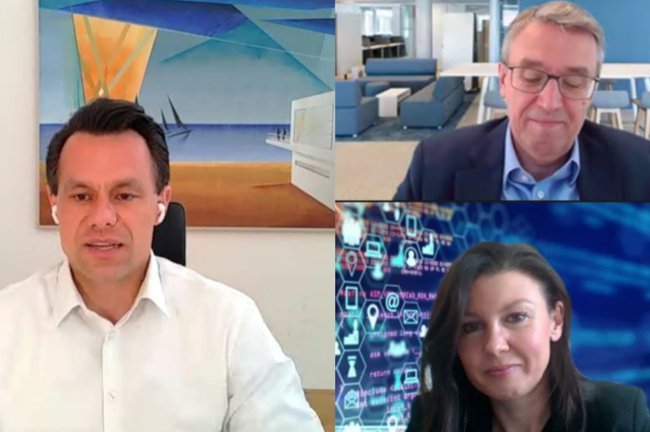Annual Reports in the World of Data
The 6th Financial Communications Symposium Addresses the Role of Annual Reports in a Data-Driven Future.

This year’s topic of the digital specialist conference is “Data Reporting? What is the Value of Reports in a Data-Driven Future?“
In 2021, the event was primarily dedicated to the topic of corporate reporting and explored the question of whether and why annual reports are still required in a digitalised and data-driven future – and if so, what the added value of annual reports is.
Financial Communication Is Affecting Us All
“Financial communication is not confined to the financial community. Eventually, its effects are relevant for everybody. Our studies on topics such as the Corporate Reporting Monitor or the access numbers for digital annual reports, demonstrate that the target group of company reporting has become very heterogeneous and that it can be located outside the capital market sphere. This is why we want to highlight the social dimensions of financial topics at our symposium”, says Monika Kovarova-Simecek, Academic Director of the master degree programme Economic and Financial Communications of the St. Pölten UAS and organiser of the symposium.
This year’s opening speeches were given by Christoph Boschan (CEO of the Vienna Stock Exchange), Harald Hagnauer (Head of Investor Relations, Österreichische Post AG) and Susanne Roiser (Head of Department, St. Pölten UAS).
In the subsequent keynote, Monika Kovarova-Simecek looked back on “250 Jahre Wiener Börse – 250 Jahre Finanzkommunikation“ (250 Years of the Vienna Stock Exchange – 250 Years of Financial Communication).
Corporate Reports in Digital Stakeholder Communication
Christian Hoffmann (Leipzig University) and Thomas Scheinwiller (University of Zürich) introduced the focus area with their current Corporate Report Monitor.
The Corporate Reporting Monitor by the Center for Corporate Reporting in Zürich, the Leipzig University and the St. Pölten UAS has been studying the reporting practices of listed companies in German-speaking countries each year since 2019. The study shows the developments, trends and benchmarks of corporate reporting, ranging from strategy and organisation to digitalisation. Companies can not only use it as a map to position themselves on but also as a compass for their future.
According to Kovarova-Simecek, most companies stick to the strategy of “PDF first” when it comes to their corporate reports. However, there is definitely a trend towards “digital first”. Consequently, most companies are in a transitional phase, moving away from print to digital formats, but they have not arrived there yet.
Reaching Target Groups through Social Media and Visualisation
However, this is not the case for Covestro, a chemical group listed on the DAX, which demonstrated through their online report how the reporting of the future can be implemented as soon as today. Convestro’s online annual report, which was drafted together with nexxar, is used as an instrument of digital stakeholder communication and integrated into the company’s communication and reporting strategy – also via social media.
Svenja Paul and Markus Kleine-Beck of Convestro and Eloy Barrantes of nexxar showed which role social media play in the success of the reporting strategy and how a corporate report can reach its target group best in today’s world.
This clearly showed: visualisation plays a central role in financial communication. In her lecture “Pictures of the Eyes and Mind”, Christina Stoiber, researcher at the St. Pölten UAS, demonstrated how we can use the particularities of human perception to effectively communicate by using data visualisation – also in the field of corporate reporting.
“One picture is worth ten thousand words – sometimes even more, but only if data visualisation is effectively to reach the target group. Graphic images in the form of data visualisation help us humans to identify connections, trends and patterns. Seeing, in other words the visual perception in our brains, is extremely fast and efficient. This allows us to quickly identify connections, trends and patterns,” says Stoiber.
Artificial Intelligence and Machine Learning
Although data processing is daily business in financial communications, “the potential of data is far from being fully exploited and the largest transformations are yet to come”, says Tassilo Pellegrini, lecturer at the Department of Digital Business and Innovation of the St. Pölten UAS in his opening statement.
In his lecture “Reporting to Machines”, Tassilo Pellegrini addressed the same topics that Harald Hagenauer of the Österreichische Post AG brought up at the beginning of the symposium.
“We have to understand that we do not only report to people but also to machine. Those who understood this logic can react accordingly”. The audience of the symposium learned if and how machines can identify the meaning of our reports and which direction data use will take in the future.
“More and more people experience on a daily basis how digitalisation is fundamentally changing financial reporting. With all that buzz wording going on, the notion that artificial intelligence has entered this field of activity is not much of a novelty anymore”, says Pellegrini.
Nevertheless, despite the many trending terms, most people do not know which technologies and methods will be used to support digital reporting in the near future in providing information.
Pellegrini’s lecture offered low-threshold insights into financial reporting and showed which core technologies will be applied in a digital reporting culture and which areas are worth establishing knowledge about as early as today in order to be among the frontrunners.
“The next generation of digital reporting will be a combination of knowledge representation (XBRL), pattern recognition (machine learning), and protocol-based trust mechanisms (blockchain). It will help to fulfil compliance requirements, breathe life into corporate governance and master the ever-growing demands on financial reporting”, says Pellegrini.
Visualisation Gallery
The concluding visualisation gallery by students of the St. Pölten UAS’ master degree programme Economic and Financial Communications demonstrated how we can depict our world in figures. This year, the students’ visualisation projects once again address the latest topics of the financial world and render the invisible visible. How many directors’ dealings were carried out in Austrian listed companies? How should we assess the role played by the IPOs of SPACs and how significant are Reddit and Twitter in the hype of GameStop?
All lectures and visualisation projects will soon be available on demand at the fincom's website.
The 6th Financial Communications Symposium was supported by the Vienna Stock Exchange, C.I.R.A, IV NÖ, PRVA, nexxar, ÖFVA, Center for Corporate Reporting and dragonfly-finance.
